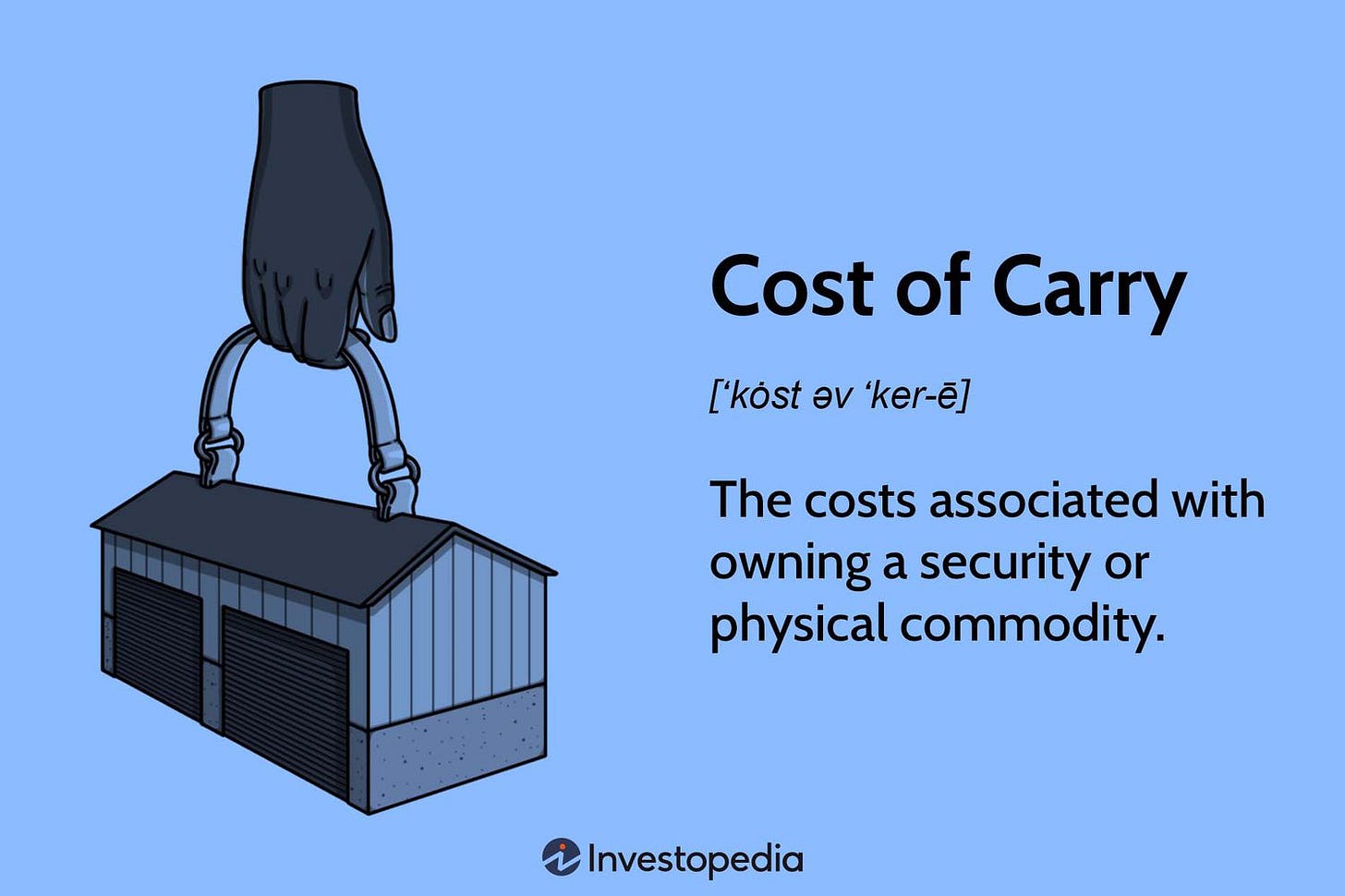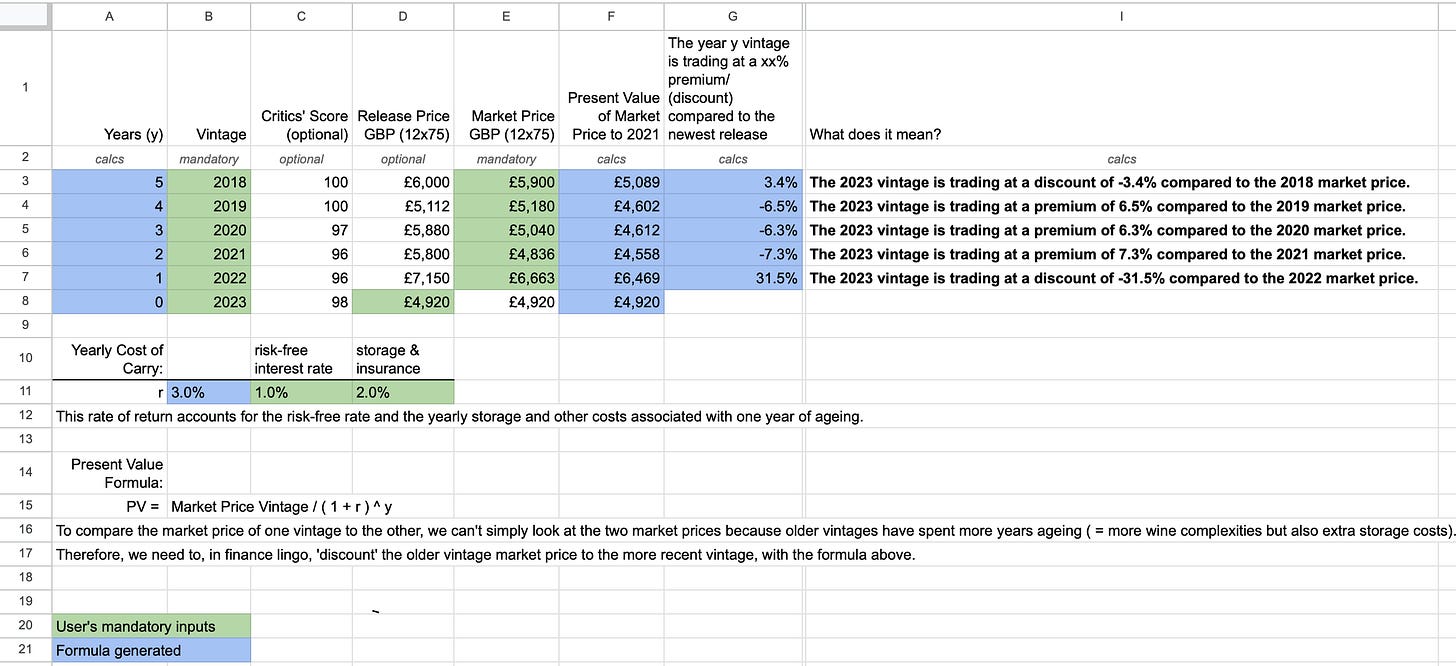Brief Finance Lesson
What is the cost of carry, and how does it affect price comparisons across different vintages?
In the mood for wine is the only weekly newsletter for the next-gen of fine wine lovers and investors. It’s free. The best way to keep it free is to share it with everyone. Literally everyone.
Hello fine wine lovers,
Bordeaux En Primeur is in full swing now, and the first prices are out. At the time of my writing, we’ve had some high-profile releases: Lafite Rothschild, Pontet-Canet, Batailley and Léoville-Las-Cases, among others. While the exact price mechanics are not revealed, they have all been released at a discount from their 2022 of, respectively: -31.2%, -26.9%, -12.9% and -40%.
I am very surprised, and many, myself included, took it as a conciliatory sign from the châteaux to their longstanding customers. Perhaps it swayed some of you, the 44% that said have lost confidence in the EP system?
Either way, I know you’re not here for the emotions, but for cold hard numbers about these prices. This will probably be the shortest and most technical article I’ve ever written. (Plus a Google sheet you can use to compare the current release price to a wine’s back vintages…)
When comparing the current release price to previous vintages, what really matters is to be able to compare it to the current market price of past vintages (NOT to their release price!)
Intuitively, if the 2023 vintage of Château X has been released at $1,000, and the market price of Château X 2019 vintage is $1000, we know that the 2019 is the bargain, because the $1000 includes the costs that the current owner had to sustain while holding this wine for 4 years.
What costs?
The Cost Of Carry!
The cost of carry is a crucial concept to understand when buying commodities.
But what is it?
DEFINITION:
The cost of carry refers to costs associated with holding a financial asset and, in this case, a commodity. When purchasing fine wine, these costs are: Financing Costs: If you borrow money to buy fine wine (highly unlikely), it would be the interest rate of the loan. Otherwise, if you buy it outright, the financing cost is the interest lost by not having those funds in a risk-free asset (a.k.a. the opportunity cost).
Currently, the risk-free rate is 5.4% in the US, 5.2% in the UK and 3.8% in Europe.
Storage & Insurance Costs: These are costs related to keeping the commodity in a condition suitable for sale or delivery.
Based on research papers, storage & insurance costs account for 1.5% to 2% per annum.
WHY DOES THE COST OF CARRY MATTER?
In fine wine, the cost of carry matters when comparing prices across vintages: we must “discount” the price of past vintages and, if you will, bring the market price to the present.
where:
PV = Present Value of Market Price of Château X 2019 vintage
Market Price Château X 2019 vintage = $1000
r_f = risk free interest rate, in our case, let’s assume it’s 3.5%
s = storage & insurance costs per annum, let’s assume it’s 1.5%
n = number of years between vintage and now. As in our example it’s 2019, we are looking at 4.
The graphic below will look very familiar to those of you that studied finance, and simply tells you that:
the further back we look, the “heavier” the cost of carry becomes.
the risk-free rate matters a lot! I mentioned this in many of my previous articles, but when interest rates are low, the cost of carry is not very “heavy”. However, when interest rates are high (like now), it makes a huge difference when discounting back vintages.
A working example
You can head to this Google Sheet, which already has the formulas set up for you, with the working example of Châteaux Lafite Rothschild vintages 2018 through 2023.
(There are many simplifications — the most important is that I used the same risk-free rate instead of the term structure: it doesn’t change much if the vintages are close to each other, but bear this in mind if you compare much older vintages.)
If you try and play around with the total cost of carry (risk-free + storage + insurance) in cell B11, you can see column F changing and consequently the discount amount in column G.
If cost of carry = 3% (as in 2009 or 2021):
If cost of carry = 7.2% (now):
Lafite 2023 is a great example of how different interest rate regimes can show a 30% decrease in release prices in a different light.
I hope this helps with your Bordeaux En Primeur 2023 campaign!
This newsletter is free for all readers and the best way to keep it free is to subscribe, re-share it with your wine-lover friends, and follow me on Instagram.
👋 Sara Danese
Comments, questions, tips? Send me a note
Here’s a reading list of some of the most liked content in this newsletter:
What LVMH sales results tell us about the state of the fine wine market
One for the cellar — Sassicaia & other Bolgheri 2021 vintage successes.
Cash-Equivalent Wines — a.k.a. a list of the best drinkable fine wines compiled by the best people in the wine trade.
A Tuscan Estate to Watch, Tenuta Sette Cieli, and why I believe this tiny Bolgheri Estate will prove a great investment.
Investment Ideas for Barolo 2019. It does what it says on the tin.
Has Fine Wine Hit Rock Bottom? ChatGPT was a fine wine investment analyst for the day, and shared which corners of the fine wine market are undervalued.
The Ministry of Silly Pricing. Discussing a few interesting releases on La Place …
How's the Champagne market looking? (Jul 2023 update) A collaboration withTom Hewsonlooking at 2013, 2014 and 2015 vintages.
The Earliest Harvest Ever. Talking about Bordeaux EP 2022.
My Fair Value a.k.a. Is Cheval Blanc Undervalued? Again, talking about Bordeaux EP 2022.
Hunting for Barolo 2019 bargains. Looking at the Ravera Cru for Barolo 2019.
Building a 36-bottle cellar, with ChatGPT. A starter cellar. (ChatGPT wasn’t a very great deal of help here.)
The Price of Wine. An economic paper on what are the drivers of fine wine prices in the long run.










Another to look at is that if that $1000 is worth $750 or 3/4 on cost of holding then it cost you $1333. How much can you buy or sell it for on market?